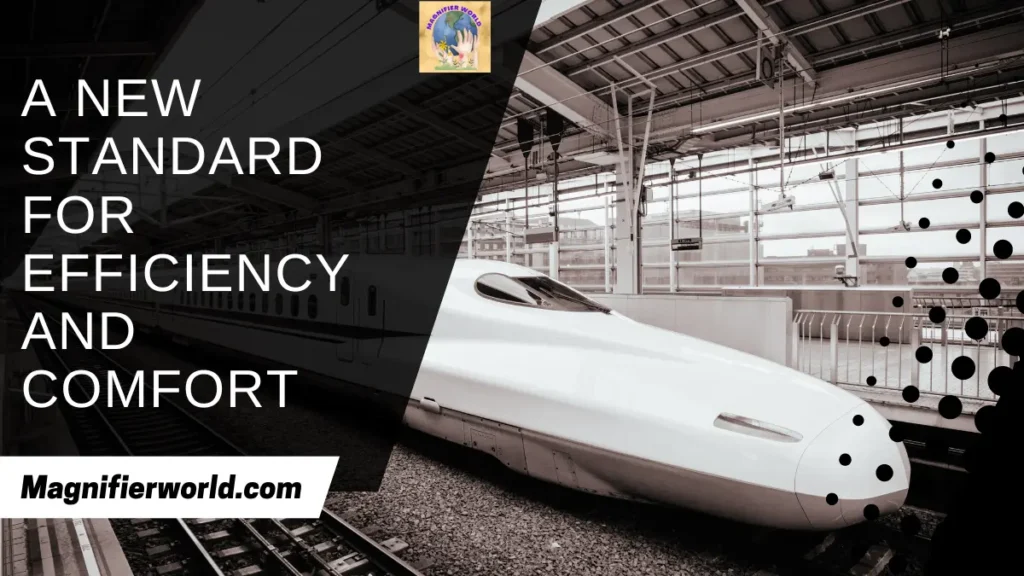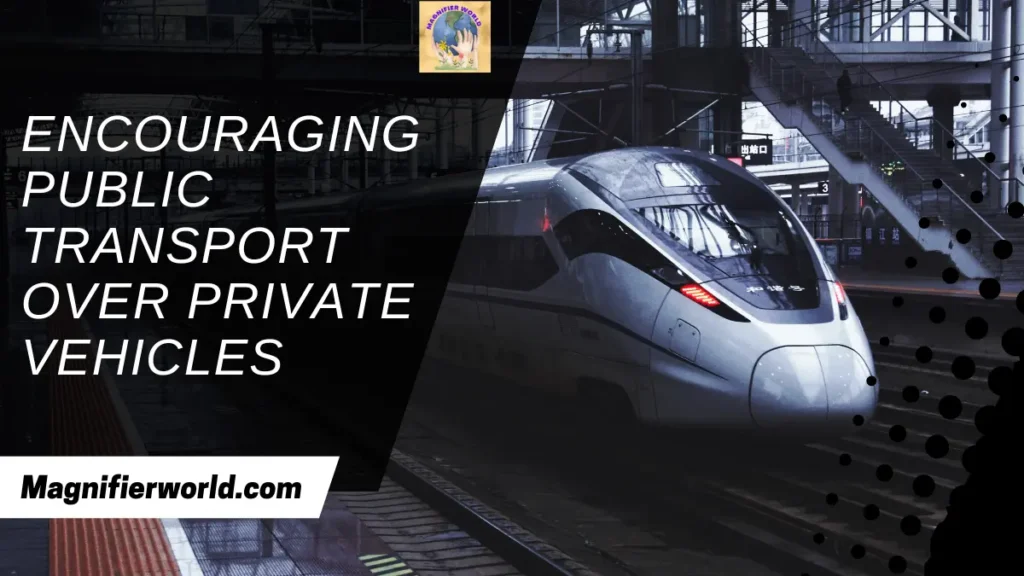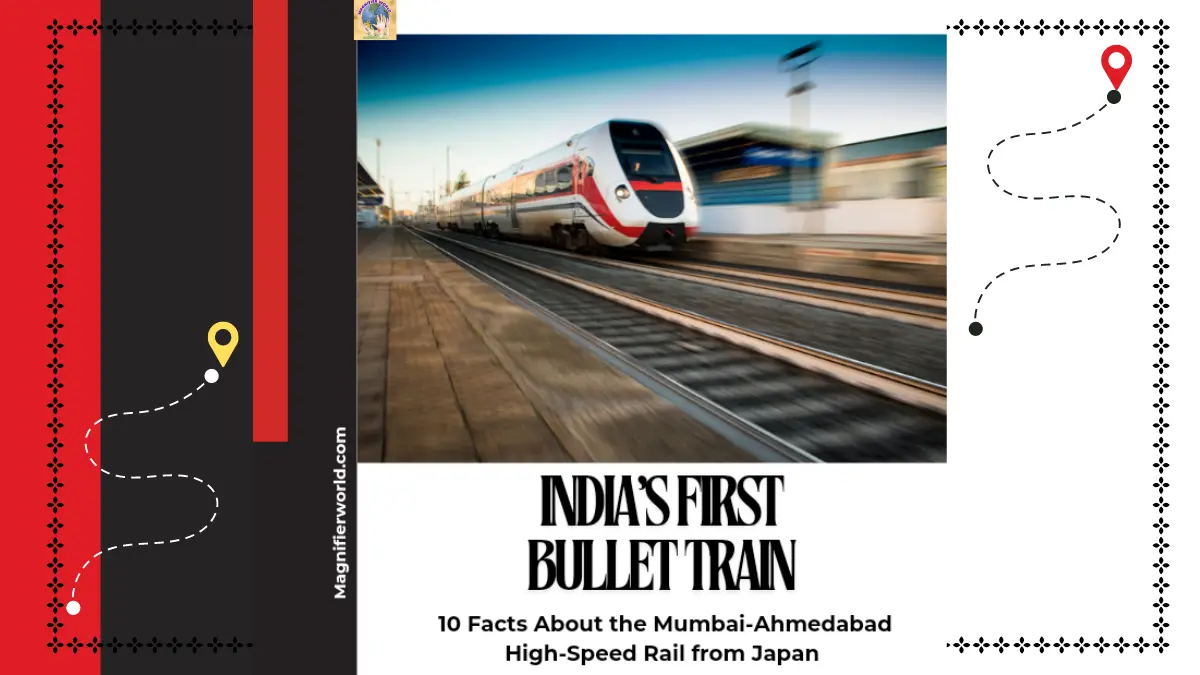India’s first bullet train marks a significant milestone in the nation’s transportation infrastructure. The Mumbai-Ahmedabad high-speed rail corridor, part of a visionary project in collaboration with Japan, introduces the concept of bullet trains to Indian railways.
This ambitious project promises not only to revolutionize how people travel but also to boost the economy and modernize infrastructure.
By reducing travel time, increasing efficiency, and setting new standards in passenger comfort, the bullet train project is poised to change the face of Indian transportation forever.

Key Takeaways from India’s First Bullet Train
- The bullet train will cut travel time between Mumbai and Ahmedabad from 7 hours to just 2 hours.
- Japan is collaborating with India to implement cutting-edge technology in the bullet train project.
- This project represents a significant step towards modernizing India’s railway infrastructure.
- The high-speed rail will boost the economy by creating new jobs and attracting foreign investments.
- The introduction of bullet trains will make domestic travel faster, safer, and more efficient.
India’s First Bullet Train: A New Era of High-Speed Connectivity

The Technological Marvel of India’s Bullet Train
India’s first bullet train project stands as a testament to the country’s ambition to bring high-speed rail travel to its citizens.
Powered by Shinkansen technology from Japan, the Mumbai-Ahmedabad corridor will enable trains to travel at speeds of up to 320 km/h (200 mph). This technology ensures smooth, safe, and reliable operations, bringing India in line with some of the world’s most advanced railway systems.
Adapting Advanced Technology for Indian Conditions
One of the most impressive aspects of the bullet train is the way Japanese technology has been adapted to suit Indian conditions. The design of the tracks, the train’s aerodynamics, and even the materials used in construction have all been customized for India’s unique geography and weather patterns.
This ensures that the bullet train will perform efficiently across the country’s diverse terrains, from the humid coastal areas to the dry interior regions.
Technological Highlights
- The bullet train uses Shinkansen technology, known for its safety and speed.
- High precision tracks designed to handle speeds of up to 320 km/h.
- Sophisticated aerodynamics that reduce wind resistance and increase energy efficiency.
- Advanced signaling systems that ensure safe and smooth operations.
- Technology adapted to withstand Indian weather conditions and geography.
Revolutionizing Indian Transportation
The introduction of the bullet train in India is set to transform the nation’s transportation landscape. The high-speed rail corridor between Mumbai and Ahmedabad will reduce travel time drastically, making it easier for people to commute between these two economic hubs.
By doing so, the project will not only improve connectivity but also enhance economic opportunities in the regions it connects.
Economic and Social Impact of the Bullet Train
The bullet train is more than just a transportation project; it is an economic engine that promises to drive growth in several key areas.
From the creation of jobs during its construction to the long-term benefits of enhanced connectivity, the bullet train will have a ripple effect on various sectors of the Indian economy.
Transforming Travel in India: The Speed Revolution
The introduction of India’s first bullet train represents a pivotal moment in the country’s transportation history. The Mumbai-Ahmedabad high-speed rail corridor will revolutionize how people travel between these two bustling cities.
With speeds of up to 320 km/h, the bullet train will slash travel time from seven hours to just two. This transformative shift will not only improve travel convenience. But also elevate India to the global stage of modern transportation systems.
Breaking the Time Barrier
One of the most significant impacts of the bullet train is its ability to break the time barrier between two major cities. The speed at which the train will operate allows for faster business trips, leisure travel.As well as daily commutes, making the region more connected than ever.
The shorter travel times will promote the idea of regional mobility, allowing residents of one city to work, study. As well as or enjoy leisure activities in another without the usual travel delays. India’s first bullet train represents a pivotal moment in the country’s transportation history.
Speed Revolution Highlights
- Travel time between Mumbai and Ahmedabad will be cut to just two hours.
- High-speed travel will enable more frequent business and leisure trips.
- The bullet train introduces a new era of daily commuting possibilities.
- Regional mobility between the two cities will enhance economic opportunities.
- Reduced travel time will foster greater cultural exchange between cities.
A New Standard for Efficiency and Comfort

Apart from speed, the bullet train promises a higher level of efficiency and passenger comfort. With advanced ticketing systems, luxurious seating arrangements, and smoother rides, passengers can expect a seamless travel experience.
High-speed trains are designed with modern amenities to ensure that the commute feels more like a comfortable journey rather than just a means to an end.
Green Transportation: A Step Towards Sustainability
One of the key benefits of the bullet train project is its potential to significantly reduce India’s carbon emissions. As the country continues to grow economically, the demand for efficient, eco-friendly transportation solutions becomes increasingly urgent.
By adopting high-speed rail, India takes a giant step towards promoting green mobility, reducing reliance on fossil fuels.As well as cutting down on pollution caused by long-distance car travel and domestic flights.
Reducing Emissions with Electric Power
The bullet train will run entirely on electric power, unlike conventional diesel trains, which contribute to significant levels of pollution. India’s first bullet train represents a pivotal moment in the country’s transportation history.
This transition to electric-powered transportation aligns with India’s broader goals of reducing carbon emissions and promoting sustainable development. India’s first bullet train project stands as a testament to the country’s ambition to bring high-speed rail travel to its citizens.
High-speed trains emit significantly less CO2 per passenger compared to airplanes. As well as cars, making them a more environmentally responsible mode of transportation.
Sustainability Highlights
- Electric-powered trains reduce reliance on fossil fuels.
- The bullet train will contribute to lowering carbon emissions.
- High-speed rail is an eco-friendly alternative to domestic flights and long-distance car travel.
- The project aligns with India’s goal of reducing its environmental footprint.
- Sustainable technology used in the trains reduces energy consumption.
Encouraging Public Transport Over Private Vehicles

By offering a faster, more efficient alternative to road travel. As well as the bullet train is expected to encourage public transport use over private vehicles.
This shift will not only reduce traffic congestion on highways but also minimize the pollution caused by the increasing number of cars on the road.
The bullet train will likely lead to a reduction in air pollution and create a healthier environment for people living in both urban and rural areas along the route.
Technological Innovation: The Future of Indian Railways
India’s first bullet train marks a new era of technological innovation in the country’s railways. By leveraging Japanese Shinkansen technology, India is adopting one of the safest and most reliable high-speed rail systems in the world.
The bullet train project will introduce state-of-the-art technology that will serve as a model for future rail projects across the nation. India’s first bullet train represents a pivotal moment in the country’s transportation history.
Boosting Job Creation and Skill Development
The construction and operation of the bullet train will create thousands of jobs, both directly and indirectly. The project will require a skilled workforce for everything from track construction to the management of train operations.
This will lead to skill development opportunities for Indian workers, who will be trained in the latest railway technology and management practices. Additionally, the creation of ancillary industries, such as maintenance, manufacturing, and tourism, will further contribute to employment growth. India’s first bullet train project stands as a testament to the country’s ambition to bring high-speed rail travel to its citizens.
Economic Impact Highlights
- Thousands of new jobs will be created during the construction phase.
- New skills and training opportunities in high-speed rail technology.
- Development of surrounding areas will boost the local economy.
- Increased tourism due to faster and more convenient travel options.
- Potential for foreign investment and partnerships in India’s rail infrastructure.
Reducing Carbon Footprint and Promoting Sustainability
The bullet train will also contribute to a greener and more sustainable future. By providing an alternative to air travel and long-distance car journeys, the high-speed rail will reduce the carbon footprint of transportation in India.
Electric-powered trains produce significantly less carbon dioxide compared to traditional diesel locomotives, making them a more eco-friendly option for long-distance travel. India’s first bullet train represents a pivotal moment in the country’s transportation history.
Furthermore, the reduced travel time will encourage more people to opt for public transport, reducing traffic congestion and air pollution in urban areas.
Infrastructure Development and Urban Connectivity
The bullet train project is driving a wave of infrastructure development in India, including the modernization of rail stations, the construction of new tracks, and the creation of smart cities around the high-speed rail corridors. India’s first bullet train project stands as a testament to the country’s ambition to bring high-speed rail travel to its citizens.
This infrastructure upgrade will not only improve the country’s transportation network but also create new opportunities for urbanization and development.
Modernizing Railway Stations
To support the bullet train’s operations, several stations along the Mumbai-Ahmedabad corridor are being upgraded to meet international standards. These stations will be equipped with modern amenities, from advanced ticketing systems to waiting lounges and retail spaces.
The modernization of stations is aimed at improving the overall travel experience for passengers, making rail travel more convenient and comfortable. Moreover, the stations will act as economic hubs, fostering the development of commercial and residential zones around them. India’s first bullet train represents a pivotal moment in the country’s transportation history.
Infrastructure Development Highlights
- Major stations are being redesigned to handle high-speed rail operations.
- New tracks and bridges built with cutting-edge engineering solutions.
- Smart city initiatives are being planned around key rail hubs.
- The bullet train project will spur urban development in underdeveloped regions.
- Improved connectivity between major cities and smaller towns.
Enhancing Inter-City Connectivity
The bullet train will significantly enhance inter-city connectivity in India, particularly between Mumbai and Ahmedabad, two of the country’s largest economic centers. By drastically reducing travel time, it will make daily commutes feasible, encouraging business travel and easing the movement of goods and people.
“Over time, the project could expand to other cities, bringing the benefits of high-speed rail travel to a broader section of the Indian population.”
Curly Tales
The Future of High-Speed Rail in India
The Mumbai-Ahmedabad bullet train is just the beginning of India’s journey into the world of high-speed rail. As the country continues to develop, there are plans to expand the high-speed rail network to other major cities. India’s first bullet train represents a pivotal moment in the country’s transportation history.
This expansion will ensure that more people across India can benefit from faster, more efficient transportation.
Expanding the Network to Other Cities
The Indian government has already announced plans to extend the high-speed rail network to other parts of the country.
Potential routes include connections between Delhi and Kolkata, Chennai and Bangalore, and Mumbai and Hyderabad. Each of these routes will further reduce travel times. As well as improve the connectivity between some of India’s most important commercial and cultural hubs. India’s first bullet train represents a pivotal moment in the country’s transportation history.
Future Expansion Highlights
- Plans for high-speed rail links between Delhi, Kolkata, and Chennai.
- Potential for the network to connect India’s economic and cultural hubs.
- Future high-speed trains could use even faster technology.
- Expanding the network will reduce congestion on existing rail lines.
- High-speed rail will play a pivotal role in India’s economic growth.
Conclusion: A Giant Leap for Indian Infrastructure
India’s first bullet train is a transformative project that will reshape the country’s transportation landscape.
By significantly reducing travel time, enhancing connectivity. As well as driving economic growth, the bullet train sets a new standard for modern infrastructure in India.
With plans for future expansion and the integration of new technological advancements, this project will serve as a cornerstone. India’s journey toward becoming a global leader in high-speed rail travel. India’s first bullet train project stands as a testament to the country’s ambition to bring high-speed rail travel to its citizens.
FAQs about India’s First Bullet Train
Q1: What is the expected speed of India’s first bullet train?
A1: The bullet train is expected to travel at speeds of up to 320 km/h (200 mph). Significantly reducing travel time between Mumbai and Ahmedabad.
Q2: When is the bullet train expected to be operational?
A2: The Mumbai-Ahmedabad bullet train is projected to be operational by 2026, although construction timelines may vary.
Q3: How will the bullet train benefit the Indian economy?
A3: The bullet train project will create jobs, attract foreign investment, and enhance inter-city connectivity, boosting the economy and promoting urban development.
Q4: What is the role of Japan in the bullet train project?
A4: Japan is providing both technological expertise and financial support for the bullet train project, particularly through its Shinkansen technology.
Q5: Will the bullet train be environmentally friendly?
A5: Yes, the bullet train will run on electric power, making it a more sustainable alternative to air travel and long-distance car journeys.






